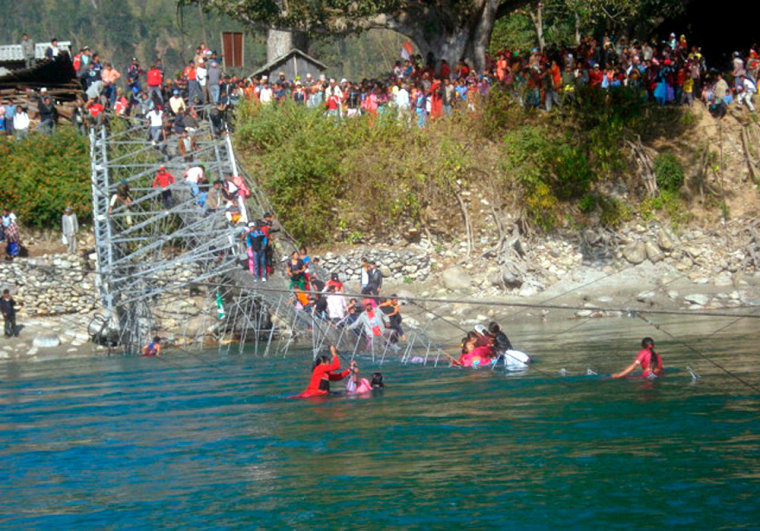Hundreds of police, soldiers and villagers searched an icy river in western Nepal on Wednesday for more than 50 people believed missing after a steel footbridge collapsed. At least 16 people were confirmed dead and dozens more were injured, officials said.
The estimate of the missing was sharply reduced from the more than 100 whose whereabouts were unknown following the collapse.
"We now think that only about 50 people could be missing," chief government administrator Anil Pandey told The Associated Press in a telephone interview.
"The reason for the higher estimate on Tuesday was the confusion and chaos that followed the accident," he said. "People saw scores of people fall in the river but many of them survived by hanging on to the cables or by managing to swim to the shore. Many people who their relatives thought were missing have also returned to the villages today."
But hopes of finding more survivors in the treacherous mountain river with its strong current were slim, Pandey said.
"We have policemen and soldiers on both sides of the river searching," he said.
One body was found on the riverbank on Wednesday, he said.
Rescuers face tough terrain
Some 500 people traveling to a village fair on Tuesday were crossing the Bheri River on the bridge when its support cables snapped under the weight, he said. The 400-foot-long bridge in Chunchu village was built this year, Pandey said, but it was not designed to hold the weight of so many people crossing at once.
Rescuers recovered 15 bodies, and 32 people who were seriously injured were flown to hospitals. Crowds that gathered after the collapse tried to save the victims and treated dozens of wounded with light injuries at the scene.
Five of the critically injured were sent to Katmandu for treatment at a military hospital. Most appeared to have head injuries and broken bones.
"Most people did not know what happened," said Durga Bika, 20, from his hospital bed in Katmandu. "The bridge collapsed and most people on the crowded bridge fell in the river. The bridge was on top of me and my leg was caught. My friends pulled me out and saved me."
Bika said he saw some people swim to safety while others were rescued by villagers. He could not say how many people were missing but concurred with the estimate by authorities of about 400 to 500 people who were on the bridge when it collapsed.
Police chief Naresh Shakya, who was coordinating the rescue, said villagers had begun to report missing relatives to officials who were traveling around the area to collect names.
The rescue team's efforts were being hampered by the area's difficult terrain, said Yam Prasad Subedi, a government official.
Remote region
Chunchu is located about 310 miles west of Katmandu in a remote part of Nepal where there are few paved roads. Most people travel by foot or bullock-pulled cart.
Much of the impoverished region's infrastructure was devastated by a decade-long communist uprising that ended last year. The country's former Maoist rebels, who controlled much of the area, often blew up bridges and roads to impede government troop movements.
The people had been on their way to a fair held every month after the full moon. The fair attracts thousands of people from surrounding villages.
